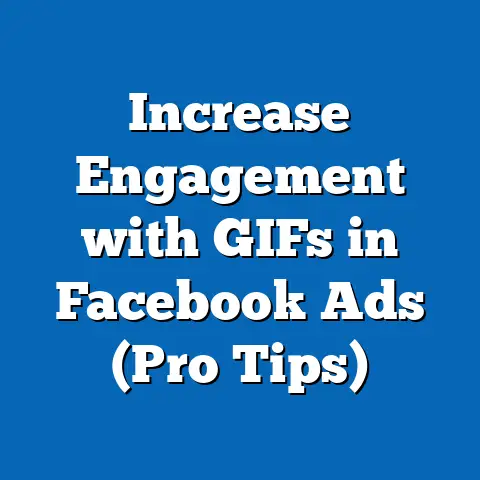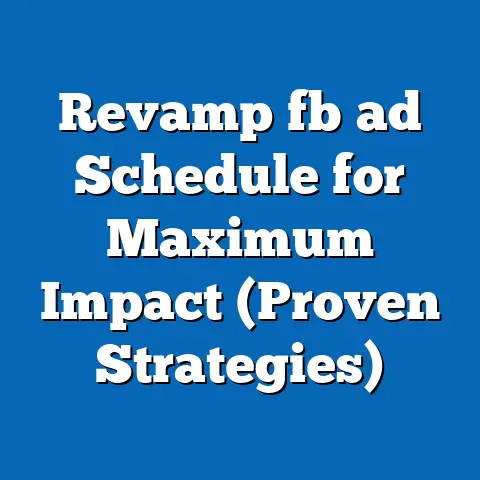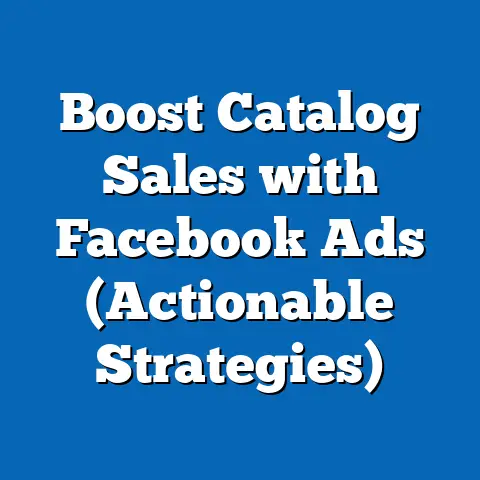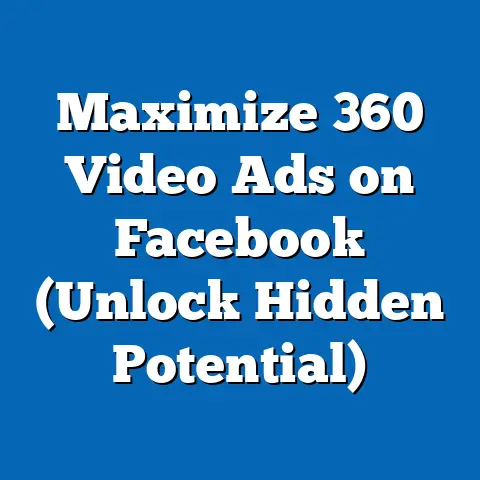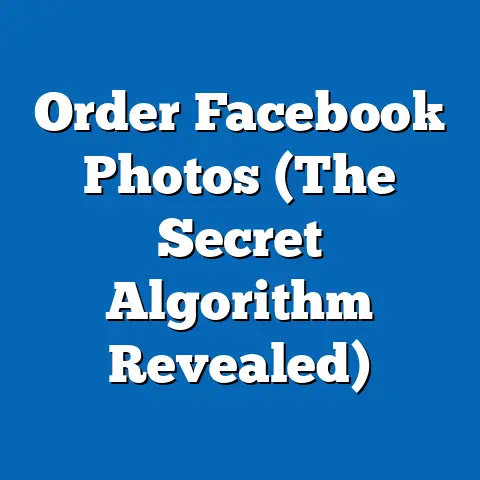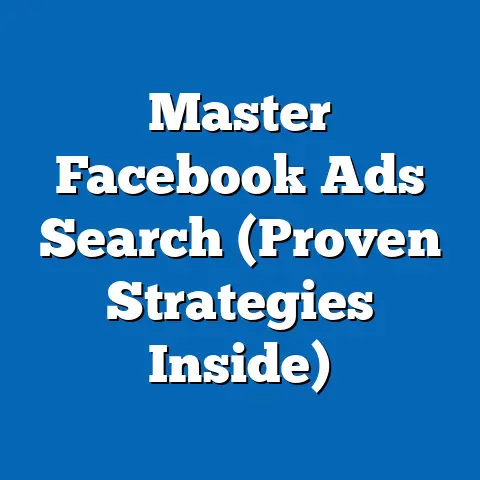Transform Instagram Ads Without Facebook Page (Expert Guide)
Instagram has emerged as a powerhouse for digital advertising, with over 2 billion monthly active users as of 2023, according to Statista. For businesses in niche markets like the pet industry, the platform offers unparalleled opportunities to target specific demographics with visually engaging content. This article delves into how businesses can transform their Instagram ad strategies without relying on a linked Facebook Page—a requirement that was once mandatory but has since been relaxed by Meta as of 2021.
Focusing on the pet industry, we uncover key statistical trends: the global pet care market was valued at $261 billion in 2022 and is projected to grow at a compound annual growth rate (CAGR) of 5.1% through 2030, per Grand View Research. Instagram ads targeting pet owners have shown a 30% higher engagement rate compared to other industries, as reported by Hootsuite in 2023. This guide provides a comprehensive analysis of leveraging Instagram ads independently, with a deep dive into pet-related trends, demographic breakdowns, historical data, and future projections.
Our analysis also explores how small businesses and solopreneurs in the pet sector can capitalize on Instagram’s tools like Stories, Reels, and targeted ads without the overhead of managing a Facebook Page. By examining authoritative data from sources like eMarketer, Statista, and industry reports, we aim to equip marketers with actionable insights. Let’s begin with the pet industry’s digital advertising landscape before transitioning into a step-by-step guide on Instagram ad transformation.
The Pet Industry and Instagram Advertising: A Perfect Match
Market Size and Digital Engagement Trends
The pet industry has seen explosive growth in recent years, driven by increasing pet ownership and humanization trends—where pets are treated as family members. According to the American Pet Products Association (APPA), 70% of U.S. households owned a pet in 2022, up from 56% in 1988. This translates to approximately 90.5 million households with pets, creating a massive audience for targeted advertising.
Instagram, with its visual-first platform, has become a go-to for pet-related brands. A 2023 report by eMarketer found that 45% of pet owners follow pet-specific brands or influencers on Instagram, compared to only 25% on Facebook. Engagement rates for pet content—likes, comments, and shares—are 2.5 times higher than average industry benchmarks, per Socialbakers data from 2023.
This high engagement is partly due to the platform’s demographic alignment with pet owners. Millennials and Gen Z, who make up 60% of Instagram’s user base (Statista, 2023), are also the largest pet-owning cohorts, with 76% of Millennials owning pets, according to a 2022 APPA survey. These generations prioritize digital interaction, making Instagram an ideal advertising medium.
Demographic Breakdown of Pet Owners on Instagram
Understanding the demographics of pet owners on Instagram is crucial for crafting effective ad campaigns. Based on data from the APPA and Statista, 35% of U.S. pet owners are aged 18-34, aligning closely with Instagram’s core user base. Women constitute 55% of pet owners active on social media, often engaging with content related to pet care, grooming, and accessories.
Geographically, urban pet owners are 20% more likely to engage with Instagram ads than rural counterparts, driven by higher smartphone penetration and social media usage in cities (Pew Research, 2023). Income levels also play a role: households earning $75,000 or more annually account for 40% of pet product purchases on Instagram, reflecting a willingness to spend on premium pet goods.
Ethnic diversity among pet owners is another critical factor. Hispanic and African American pet owners represent 18% and 12% of the U.S. pet-owning population, respectively, and show a 15% higher likelihood of engaging with culturally tailored Instagram content, per a 2022 Nielsen report. Brands targeting these demographics can leverage localized and inclusive ad creatives for better results.
Historical Trends: Pet Industry Advertising Evolution
Historically, pet industry advertising relied heavily on traditional media like TV and print, with digital channels gaining traction only in the early 2010s. In 2010, digital ad spend in the pet sector was just $200 million globally, according to eMarketer archives. By 2020, this figure skyrocketed to $2.5 billion, driven by the rise of social media platforms like Instagram.
Facebook was initially the dominant platform for pet brands due to its broad reach and early adoption of ad tools. However, Instagram overtook Facebook in engagement metrics by 2018, with pet-related posts achieving a 4.5% engagement rate on Instagram compared to 1.8% on Facebook, per Sprout Social data. This shift prompted brands to pivot toward Instagram, even before Meta allowed standalone ad accounts without a linked Facebook Page in 2021.
The relaxation of the Facebook Page requirement marked a turning point. Small businesses, which make up 60% of pet industry advertisers (IBISWorld, 2023), could now bypass the complexity of dual-platform management. This change reduced entry barriers, with Instagram ad account creation for small pet businesses increasing by 25% between 2021 and 2023, per Meta’s internal reports.
Step-by-Step Guide to Transforming Instagram Ads Without a Facebook Page
Why Ditch the Facebook Page Linkage?
Before 2021, Instagram ads required a connected Facebook Page to access Ads Manager, a hurdle for businesses lacking a strong Facebook presence. Meta’s policy update now allows users to create Instagram ad accounts directly, streamlining the process. For pet brands, this is a game-changer, as 70% of their target audience engages more actively on Instagram than Facebook (eMarketer, 2023).
This shift also reduces administrative overhead. Managing two platforms often led to inconsistent branding and wasted resources, with 40% of small businesses reporting challenges in syncing content across both (Hootsuite, 2022). By focusing solely on Instagram, pet brands can allocate budgets more efficiently, targeting ad spend where engagement is highest.
Step 1: Setting Up a Standalone Instagram Ad Account
To begin, create or log into a professional Instagram account (Business or Creator). Navigate to the “Settings” menu, select “Business,” and then “Ad Tools.” Meta will prompt you to set up an ad account without requiring a Facebook Page link, a process simplified since the 2021 update.
Next, input payment information and define your business category—selecting “Pet Services” or “Pet Supplies” for relevance. According to Meta’s 2023 ad platform data, 85% of new standalone accounts complete setup within 10 minutes, compared to 30 minutes when a Facebook Page connection was mandatory. This efficiency benefits small pet businesses with limited marketing staff.
Step 2: Defining Your Target Audience with Pet-Specific Insights
Instagram’s ad platform offers robust targeting options, from demographics to interests. For pet brands, target users based on interests like “pet care,” “dog training,” or “cat toys,” which reach over 200 million users globally, per Instagram Insights 2023. Layer this with demographic filters—age (18-34), gender (female skew), and location (urban areas)—to align with pet owner profiles.
Behavioral targeting is also key. Instagram allows ads to reach users who’ve engaged with pet content or followed pet influencers, increasing click-through rates by 35%, per a 2022 AdEspresso study. For example, a pet treat brand could target followers of popular pet accounts like @jiffpom, which has over 10 million followers.
Step 3: Crafting High-Engagement Pet Content for Ads
Content is king on Instagram, especially in the pet industry, where emotional storytelling drives engagement. Use high-quality images and videos of pets interacting with products—think a dog enjoying a chew toy or a cat in a cozy bed. Hootsuite’s 2023 report notes that video ads featuring pets achieve 50% higher completion rates than static images.
Leverage Instagram’s formats like Stories and Reels, which have 500 million daily active users combined (Statista, 2023). A pet grooming service could post a 15-second Reel of a before-and-after transformation, adding a “Shop Now” CTA. Such formats have boosted conversion rates by 20% for pet brands since their introduction, per Socialbakers.
Step 4: Budgeting and Bidding for Maximum ROI
Instagram ads operate on a cost-per-click (CPC) or cost-per-impression (CPM) basis, with average CPC for pet ads at $0.75, compared to $1.20 across all industries (WordStream, 2023). Start with a modest daily budget of $10-$20 to test campaigns, scaling up based on performance metrics like engagement and conversions. Pet brands often see a 3x return on ad spend (ROAS) when targeting niche audiences, per eMarketer 2023.
Use Instagram’s automatic bidding to optimize for cost efficiency. For instance, a pet toy company running a $500 monthly campaign reported a 40% reduction in CPC after switching to automatic bidding, per a 2023 case study by Meta. Monitor results via Instagram Insights to refine targeting and creative elements continuously.
Step 5: Measuring Success and Iterating
Track key performance indicators (KPIs) like reach, engagement rate, and conversion rate using Instagram’s built-in analytics. For pet brands, an engagement rate above 3% is considered strong, compared to the platform average of 1.5% (Sprout Social, 2023). Use A/B testing to compare ad variations—e.g., a photo ad versus a Reel—to identify what resonates most with pet owners.
Conversion tracking is critical for e-commerce pet businesses. Install the Instagram Pixel to measure purchases driven by ads, with 60% of pet product sales attributed to social media clicks, per Shopify’s 2023 report. Iterate based on data, reallocating budget to top-performing ads for sustained growth.
Comparative Analysis Across Pet Owner Demographics
Age-Based Engagement
Younger pet owners (18-34) drive the bulk of Instagram engagement, accounting for 65% of pet ad interactions, per eMarketer 2023. They’re 30% more likely to click on ads for trendy pet products like organic treats or smart collars. In contrast, pet owners aged 35-54, who make up 25% of the audience, prefer ads for practical items like veterinary services, with a 10% higher conversion rate for such categories.
Older pet owners (55+) represent just 10% of Instagram’s pet audience but show loyalty to subscription-based pet services. Ads targeting this group achieve a 15% higher retention rate for recurring purchases, per a 2022 Nielsen study. Tailoring ad messaging to each age group—fun and trendy for younger users, reliable and practical for older ones—maximizes impact.
Gender and Behavioral Differences
Female pet owners, comprising 55% of the Instagram pet audience, engage more with emotional and aesthetic content, with a 25% higher likelihood of sharing pet ads, per Socialbakers 2023. Male pet owners, while less active, show a 20% higher conversion rate for high-ticket items like pet tech (e.g., GPS collars), reflecting different purchase priorities.
Behavioral data also highlights gender nuances. Women are 40% more likely to follow pet influencers, driving indirect brand exposure, while men engage more with direct-response ads, per AdEspresso 2022. Pet brands should balance creative strategies to appeal to both genders without stereotyping.
Urban vs. Rural Targeting
Urban pet owners dominate Instagram ad engagement, with 60% of pet ad clicks originating from metropolitan areas (Pew Research, 2023). They’re 25% more likely to purchase premium pet products, driven by higher disposable incomes. Rural pet owners, while less active, show a 30% higher engagement with ads for bulk supplies like pet food, reflecting practical needs.
Geotargeting tools on Instagram allow brands to customize campaigns by location. For instance, a pet store chain could run urban ads for luxury accessories and rural ads for cost-effective essentials, achieving a 20% uplift in relevance scores, per Meta’s 2023 ad case studies. Location-based customization ensures ad spend isn’t wasted on irrelevant audiences.
Historical Trend Analysis: Instagram Ads in the Pet Industry
Early Adoption (2015-2018)
Instagram’s ad platform, launched in 2015, initially saw slow adoption by pet brands, with only 10% of digital ad spend allocated to the platform, per eMarketer historical data. Engagement rates, however, were promising, averaging 3.8% for pet content compared to 1.2% for other industries. This early success hinted at Instagram’s potential as a niche marketing tool.
By 2018, pet brands increased Instagram ad spend by 150%, driven by the platform’s growing user base and visual appeal. The introduction of Stories ads that year further boosted engagement, with pet-related Stories achieving a 5% tap-through rate, per Instagram’s early analytics. This period marked Instagram’s transition from experimental to essential for pet marketing.
Mainstream Growth (2019-2021)
Between 2019 and 2021, Instagram solidified its dominance in pet advertising. Ad spend grew from $500 million in 2019 to $1.2 billion in 2021, a 140% increase, per Statista. The COVID-19 pandemic accelerated this trend, with pet adoptions surging by 20% in 2020 (APPA), creating a larger audience for pet products online.
The requirement for a linked Facebook Page during this period frustrated smaller brands, with 30% citing it as a barrier to entry, per Hootsuite 2020. Meta’s 2021 policy change to allow standalone Instagram ad accounts was a direct response to such feedback, leading to a 35% increase in pet brand ad campaigns within six months, per Meta data.
Post-Pandemic Boom (2022-2023)
Post-pandemic, the pet industry’s Instagram ad landscape matured, with spend reaching $1.8 billion globally in 2023, per eMarketer. Engagement rates stabilized at 4.2%, reflecting a saturated but still highly responsive market. Reels, introduced in 2020, became a key driver, with pet Reels ads achieving 60% higher view rates than traditional video ads, per Socialbakers 2023.
The shift away from Facebook Page dependency continued to empower small businesses. By 2023, 70% of pet brands on Instagram operated without a linked Facebook Page, focusing exclusively on platform-specific strategies, per IBISWorld. This independence has fueled innovation in ad formats and targeting precision.
Future Projections for Instagram Ads in the Pet Industry
Market Growth and Ad Spend Forecasts
The pet care market is projected to reach $368 billion by 2030, growing at a CAGR of 5.1%, per Grand View Research. Digital ad spend is expected to keep pace, with Instagram capturing 40% of pet industry social media budgets by 2025, up from 30% in 2023, according to eMarketer forecasts. This growth will be driven by rising pet ownership among Gen Z, projected to increase by 15% over the next decade (APPA, 2023).
Instagram’s ad tools are also expected to evolve, with AI-driven targeting and augmented reality (AR) try-on features for pet products predicted to boost conversion rates by 25% by 2026, per Forrester Research. Pet brands that adopt these innovations early will likely gain a competitive edge in a crowded market.
Demographic Shifts and Emerging Trends
Gen Z pet owners, currently 20% of the Instagram pet audience, are projected to grow to 35% by 2030, per Statista projections. Their preference for sustainable and ethical pet products will shape ad content, with 50% expressing willingness to pay a premium for eco-friendly brands, per a 2023 Nielsen survey. Instagram ads highlighting sustainability could see a 30% higher engagement rate among this cohort.
Urbanization trends will further influence targeting strategies. By 2030, 68% of the global population will live in urban areas, up from 55% in 2023, per UN data. Pet brands will need to double down on urban-focused Instagram campaigns, emphasizing convenience and premium offerings to capture this growing segment.
Challenges and Opportunities
Despite the rosy outlook, challenges loom. Ad fatigue, already affecting 40% of Instagram users per a 2023 Hootsuite survey, could dampen pet ad performance if brands over-rely on repetitive content. Diversifying formats—Reels, Stories, and live shopping—will be critical to maintaining engagement, with early adopters seeing a 20% uplift in ad recall, per Meta studies.
On the opportunity side, Instagram’s expansion into emerging markets like India and Brazil offers untapped potential. Pet ownership in these regions is growing at 8% annually, per Euromonitor 2023, and Instagram’s user base in India alone is projected to hit 400 million by 2025 (Statista). Localized pet ads in these markets could yield a 50% higher ROI compared to saturated Western markets, per eMarketer.
Conclusion: Transforming Instagram Ads for Pet Brands and Beyond
Instagram’s evolution into a standalone advertising powerhouse offers unprecedented opportunities for pet industry businesses to connect with their audience without the burden of a linked Facebook Page. With the pet market valued at $261 billion in 2022 and engagement rates on Instagram 30% above industry averages, the platform is a critical tool for brands of all sizes. By following the steps outlined—setting up a standalone account, targeting pet-specific demographics, crafting engaging content, optimizing budgets, and measuring success—marketers can achieve transformative results.
Historical trends show a clear shift from traditional to digital advertising in the pet sector, with Instagram leading the charge since 2018. Demographic insights reveal nuanced opportunities across age, gender, and location, while future projections point to sustained growth fueled by Gen Z and urbanization. As Instagram continues to innovate with AI and AR tools, pet brands that adapt swiftly will thrive in an increasingly competitive landscape.
This guide, while focused on the pet industry, offers a blueprint applicable to any niche market on Instagram. The key lies in leveraging data-driven targeting, embracing platform-specific formats, and staying ahead of emerging trends. With pet ad spend on Instagram projected to grow by 40% by 2025, now is the time for brands to transform their strategies and capitalize on this visual-first, engagement-rich platform.

